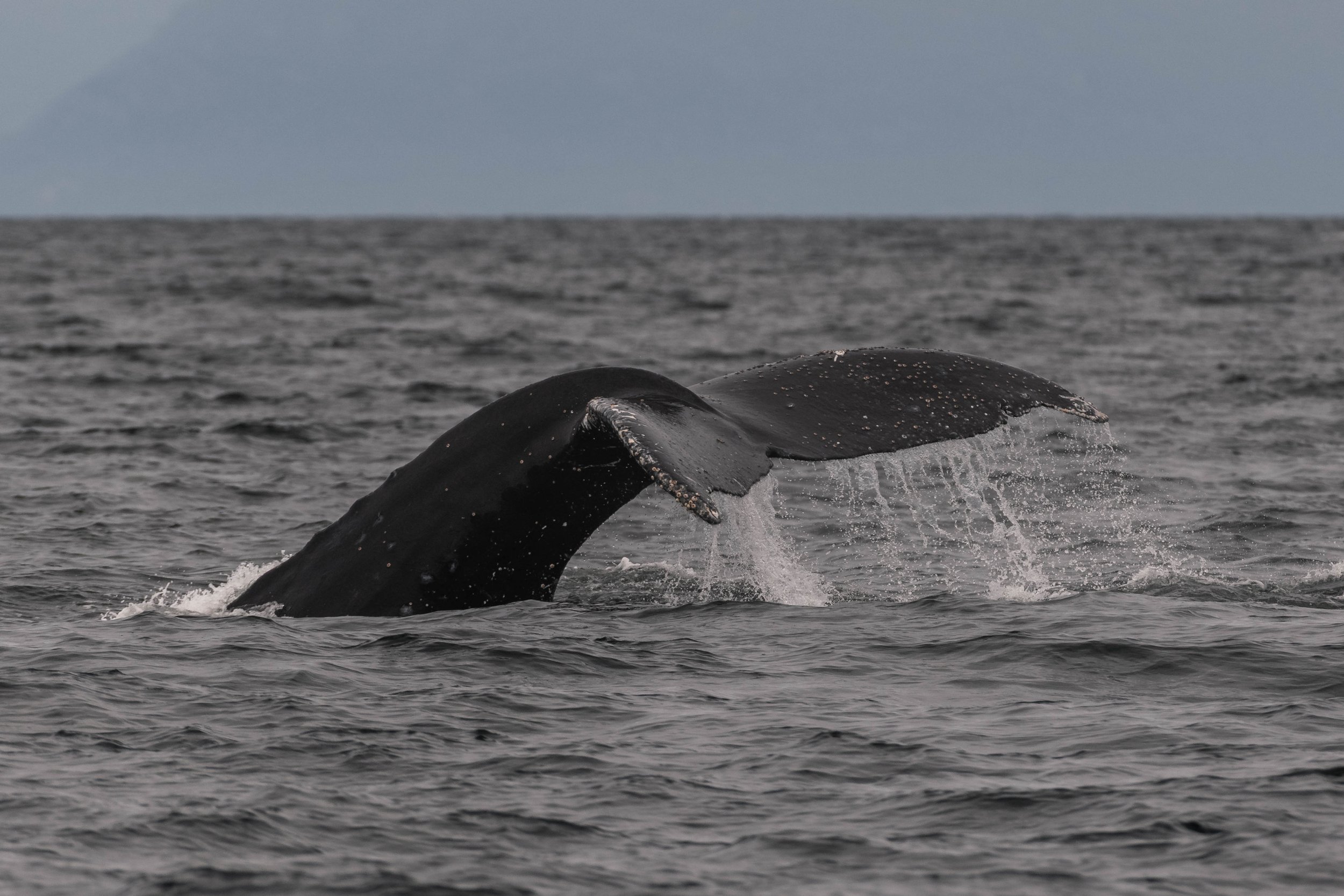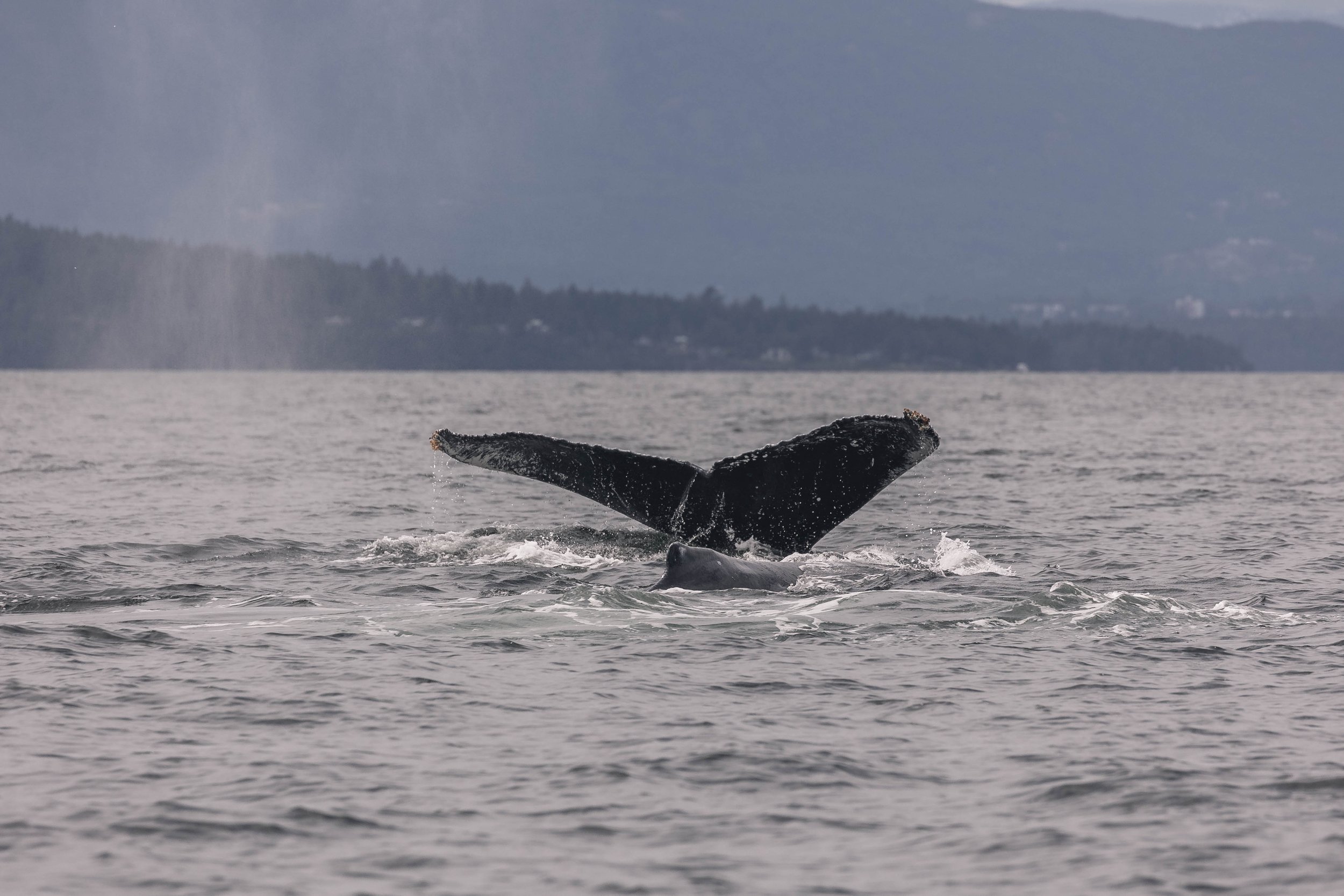June 4, 2025, 10:30 AM - Humpbacks everywhere we looked!
It was a classic West Coast day as two of our vessels departed Nanaimo Harbour this morning. The cloud cover overhead provided ideal lighting conditions as we set out on our search, and it didn’t take long before we found our first humpback: Deca (BCY1229). Deca appeared to be enjoying their time at the surface, treating us to a variety of exciting behaviours during our encounter.
While it wasn’t entirely clear whether Deca was playing or feeding, it was certainly entertaining to watch. We saw lots of flicking, tail hovering at the surface, and even some sideways tail lifts, always an exciting sight! We don’t always witness these types of behaviours, and while they’re not always easy to interpret, it’s a real treat when we do. With movements like these, there’s a chance Deca was playing with kelp or seaweed just below the surface. Although we didn’t see it firsthand today, that’s our best guess.
Later, our semi-covered boat spotted another whale, one engaged in longer feeding dives. While we didn’t get many looks, we managed to get a good enough photo to confirm the ID: Anvils 2022 calf (BCZ0410calf2022). Upon reviewing the photos, we noticed this young whale was absolutely covered in barnacles.
It’s not fully understood why some whales have more barnacle coverage than others. While it’s very common for humpbacks to host barnacles, especially in areas with lower water flow, like their pectoral fins, chins, and tail fluke edges, this little whale had barnacles spread across its entire body, which is less common.
Whale barnacles are truly fascinating. They’re species-specific, meaning the barnacles found on humpbacks differ from those on gray whales or other species. In their larval stage, barnacles are free-swimming members of the zooplankton community. When they detect the right chemical cues from a whale, they settle onto the skin, burrow their heads in, and begin forming calcareous plates around their bodies. Once attached, they leave their feeding appendages, essentially their “feet”, sticking out into the water to capture food particles, feeding on similar prey as the whales, just on a much smaller scale. This passive feeding strategy requires little energy, which benefits the barnacle. For the whale, these hard plates can provide a small degree of protection and even serve as extra impact force if they need to defend themselves or their calves, particularly from threats like Transient Orcas.
Our next sighting included X_pialidocious (KEY059) and Slits (BCY0946), and they, too, were carrying a few extra passengers. Slits, in particular, had barnacles covering her rostrum (the front of her face). Although barnacles usually don’t harm whales directly, in large enough numbers, they can cause drag and potentially affect energy efficiency. Removing them isn't easy, since they’re embedded into the skin. Luckily, humpbacks have their own removal strategy: behaviours like breaching, tail slapping, and pectoral fin slapping may help dislodge these hitchhikers. It may seem like overkill, but some estimates suggest barnacles can add nearly 1,000 pounds to a whale’s body, so it makes sense for the whales to shake them off!
To wrap up the tour, we headed over to Sticky Rock, where we spotted both Harbour Seals and Steller Sea Lions. With the tide rising, many of the usual haul-out rocks were submerged, and the remaining dry spots were in high demand. A few determined seals were seen trying to stay perched on the last remaining rocks, some even striking the classic “banana pose”, a surefire sign of a happy seal. We were also lucky enough to spot a Bald Eagle keeping a watchful eye as we cruised past.
It was a fantastic day on the water, filled with incredible wildlife sightings and unique behaviours from the whales. Our onboard Marine Naturalists, Aly Kohlman and Hayleigh Hilbert, captured some stunning photos throughout the trip—be sure to check them out below!
A look at Deca’s right flank. Photo by Aly Kohlman.
The underside of Deca’s tail flukes. Photo by Aly Kohlman.
A sharp turn from Deca as they played at the surface. Photo by Aly Kohlman.
A sideways fluke from Deca. Photo by Aly Kohlman.
Deca swishing their tail at the surface. Photo by Aly Kohlman.
Can you see the small notch in Deca’s dorsal fin? Photo by Hayleigh Hilbert.
The tips of Deca’s tail flukes. Photo by Hayleigh Hilbert.
The left side of Anvil’s 2022 calf. Photo by Aly Kohlman.
A lovely fluke waterfall from Anvils 2022 calf. Photo by Aly Kohlman.
Slits’ rostrum is covered with barnacles! Photo by Aly Kohlman.
The left side of Slits’ dorsal fin. Photo by Aly Kohlman.
X_pialidocious’ dorsal fin. Photo by Aly Kohlman.
The under side of X_pialidocious’ tail flukes. Photo by Aly Kohlman.
X_pialidocious lifting their tail to dive. Photo by Aly Kohlman.
Slits creating a fluke waterfall as she dove. Photo by Aly Kohlman.
X_pialidocious going for a dive. Photo by Aly Kohlman.
Slits arching her back for a dive. Photo by Hayleigh Hilbert.
The right side of Slits’ dorsal fin. Photo by Hayleigh Hilbert.
X_pialidocious going for a dive. Photo by Hayleigh Hilbert.
A beautiful look at the underside of Slits’ tail. Photo by Hayleigh Hilbert.
X_pialidocious flicking their tail at the surface! Photo by Hayleigh Hilbert.
Slits going for a dive with X_pialidocious surfacing just in front of her. Photo by Hayleigh Hilbert.
The underside of X_pialidocious’ tail. Photo by Hayleigh Hilbert.
A big flick at the surface from X_pialidocious. Photo by Hayleigh Hilbert.
X_pialidocious going for a dive. Photo by Hayleigh Hilbert.
Cascadia watching the whales! Photo by Aly Kohlman.
A lovely banana pose from one of the Harbour Seals. Photo by Aly Kohlman.
Some Harbour Seals sharing the last rocks left by the tide. Photo by Aly Kohlman.
A happy Harbour Seal on the rock. Photo by Hayleigh Hilbert.
Some Black Oyster Catchers spending time on Stinky Rock. Photo by Hayleigh Hilbert.
A Bald Eagle watching us from the rocks. Photo by Hayleigh Hilbert.
A massive male Steller Sea Lion amongst the smaller females and juveniles. Photo by Aly Kohlman.
Look at the size difference between the males and the others! Photo by Hayleigh Hilbert.
Can you spot the bald eagle in the background of this photo? Photo by Hayleigh Hilbert.
A mature male Steller Sea Lion spending time relaxing in the water. Photo by Hayleigh Hilbert.
A bald eagle watching from the sign. Photo by Aly Kohlman.
Harlequin ducks on Stinky Rock. Photo by Aly Kohlman.
A River Otter playing on the docks. Photo by Aly Kohlman.
A River Otter with her tongue out. Photo by Aly Kohlman.







































